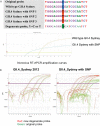A Single Nucleotide Polymorphism at the TaqMan Probe-Binding Site Impedes Real-Time Reverse Transcription-PCR-Based Detection of Norovirus GII.4 Sydney
- PMID: 26202114
- PMCID: PMC4572533
- DOI: 10.1128/JCM.01044-15
A Single Nucleotide Polymorphism at the TaqMan Probe-Binding Site Impedes Real-Time Reverse Transcription-PCR-Based Detection of Norovirus GII.4 Sydney
Abstract
A single nucleotide polymorphism (SNP) in the TaqMan probe-binding site resulted in decreased sensitivity of real-time reverse transcription-PCR (RT-rtPCR) for detection of norovirus genogroup II genotype 4 (GII.4) Sydney. A new degenerate probe was designed that improved the sensitivity of the detection while not interfering with the detection of other GII and GI strains.
Copyright © 2015, American Society for Microbiology. All Rights Reserved.
Figures

Similar articles
-
A one-step multiplex real-time RT-PCR assay for rapid and simultaneous detection of human norovirus genogroup I, II and IV.J Virol Methods. 2013 May;189(2):277-82. doi: 10.1016/j.jviromet.2013.02.004. Epub 2013 Feb 27. J Virol Methods. 2013. PMID: 23454645
-
Optimization of one-step real-time reverse transcription-polymerase chain reaction assays for norovirus detection and molecular epidemiology of noroviruses in Thailand.J Virol Methods. 2013 Dec;194(1-2):317-25. doi: 10.1016/j.jviromet.2013.08.033. Epub 2013 Sep 23. J Virol Methods. 2013. PMID: 24070785
-
Evaluation of real-time RT-PCR assays for detection and quantification of norovirus genogroups I and II.Virol Sin. 2017 Apr;32(2):139-146. doi: 10.1007/s12250-016-3863-9. Epub 2017 Feb 20. Virol Sin. 2017. PMID: 28224385 Free PMC article.
-
Evaluation of RIDA®GENE norovirus GI/GII real time RT-PCR using stool specimens collected from children and adults with acute gastroenteritis.J Clin Virol. 2018 Jul;104:1-4. doi: 10.1016/j.jcv.2018.04.006. Epub 2018 Apr 10. J Clin Virol. 2018. PMID: 29702350 Free PMC article.
-
Multiplex real-time RT-PCR for the simultaneous detection and quantification of GI, GII and GIV noroviruses.J Virol Methods. 2015 Oct;223:109-14. doi: 10.1016/j.jviromet.2015.07.020. Epub 2015 Aug 3. J Virol Methods. 2015. PMID: 26248055
Cited by
-
Norovirus trends in British Columbia from 2021 to 2022: the relationship between wastewater surveillance and clinical outbreak data during the COVID-19 pandemic.Sci Rep. 2025 Jul 2;15(1):22614. doi: 10.1038/s41598-025-06940-8. Sci Rep. 2025. PMID: 40596393 Free PMC article.
-
Identification of CYP2D6 Haplotypes that Interfere with Commonly Used Assays for Copy Number Variation Characterization.J Mol Diagn. 2021 May;23(5):577-588. doi: 10.1016/j.jmoldx.2021.01.013. Epub 2021 Feb 22. J Mol Diagn. 2021. PMID: 33631352 Free PMC article.
References
-
- Siebenga JJ, Vennema H, Zheng DP, Vinje J, Lee BE, Pang XL, Ho EC, Lim W, Choudekar A, Broor S, Halperin T, Rasool NB, Hewitt J, Greening GE, Jin M, Duan ZJ, Lucero Y, O'Ryan M, Hoehne M, Schreier E, Ratcliff RM, White PA, Iritani N, Reuter G, Koopmans M. 2009. Norovirus illness is a global problem: emergence and spread of norovirus GII.4 variants, 2001–2007. J Infect Dis 200:802–812. doi:10.1086/605127. - DOI - PubMed
-
- van Beek J, Ambert-Balay K, Botteldoorn N, Eden JS, Fonager J, Hewitt J, Iritani N, Kroneman A, Vennema H, Vinje J, White PA, Koopmans M, NoroNet. 2013. Indications for worldwide increased norovirus activity associated with emergence of a new variant of genotype II.4, late 2012. Euro Surveill 18:8–9. http://www.eurosurveillance.org/ViewArticle.aspx?ArticleId=20345. - PubMed
-
- Mattison K, Grudeski E, Auk B, Brassard J, Charest H, Dust K, Gubbay J, Hatchette TF, Houde A, Jean J, Jones T, Lee BE, Mamiya H, McDonald R, Mykytczuk O, Pang X, Petrich A, Plante D, Ritchie G, Wong J, Booth TF. 2011. Analytical performance of norovirus real-time RT-PCR detection protocols in Canadian laboratories. J Clin Virol 50:109–113. doi:10.1016/j.jcv.2010.10.008. - DOI - PubMed
Publication types
MeSH terms
Substances
LinkOut - more resources
Full Text Sources
Medical

